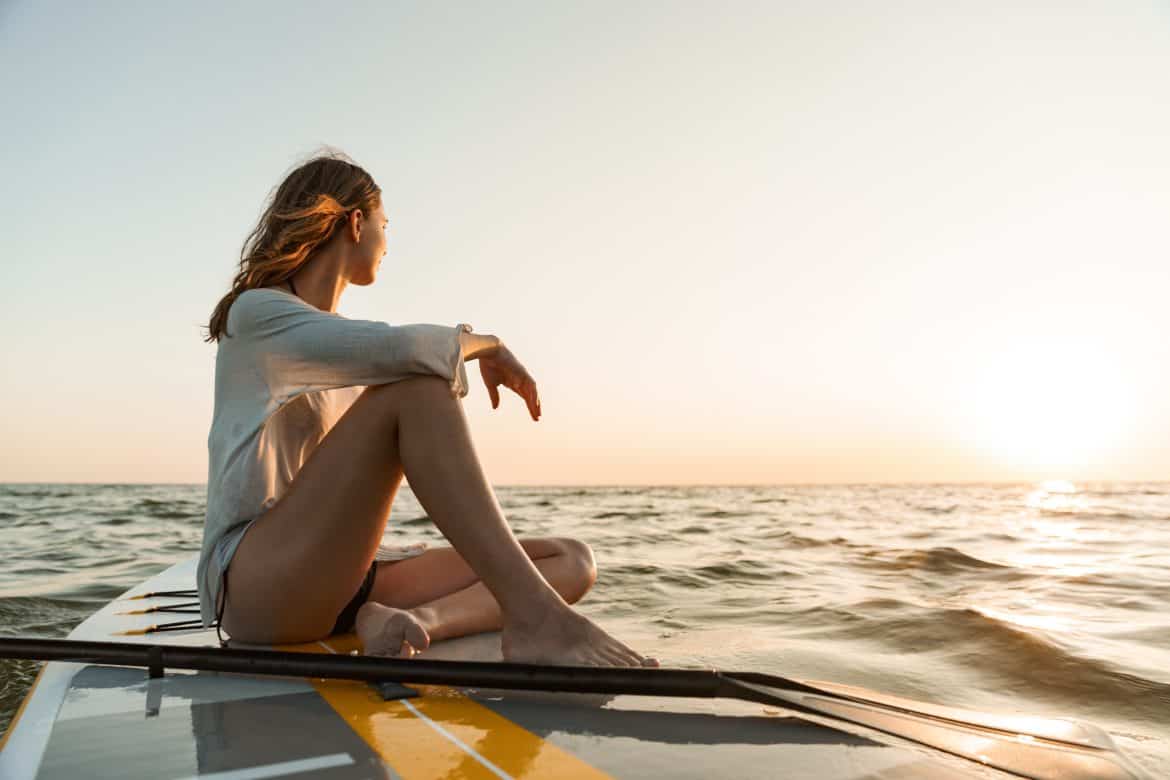Paddle boarding is a great outdoor sport that all beach and water lovers can try. It’s easy to learn, most people manage to paddle out without falling in their first try. It’s also a great low impact exercise. This is why it is gaining popularity fast. It is difficult to overlook people stand up paddling when you head to the beach or other local water bodies.
Even though the sport is quite easy, you will still need some paddle boarding specific equipment before launching out. If you are a beginner this article will help you out. We have listed all the essential gear pieces that you will need if you want to try paddle boarding. After you are done with this article and you know what pieces of gear you need, you will also want to check out some of the reviews. Which piece of gear and what brand to choose etc… so to do this you should check out online paddle boarding reviews, such as Onyx Motion Paddle Sports.
Some pieces like a paddle board and a paddle are inevitable, you can not padle without them. Others will just make your paddles easier and safer. OK, so this is what you need:
Paddle Board
Paddleboards are essential. No board, no paddling. This is what you stand on when paddling.
Paddle boards are used in very different ways, which include lying, kneeling, or standing up. The more traditional paddle boarders who kneel or lie on the paddle board propel themselves on the board by the swimming motion of their arms. In stand-up (SUP) paddle boarding, paddle boarders engage in the sport by using paddles with the paddle board.
There are various types of paddle boards to pick from. Key decision factors in paddle boards include shape, size, volume. There are also solid and inflatable board options. Solid are more rigid and faster but inflatable are way more practical as they can be rolled up and stored and a bag. When it comes to shape size and volume this is what you need to know:
- wider, high volume boards are more stable and suitable for beginners and intermediates
- narrower nad longer boards are less stable but faster when paddling and are suitable for long distance paddling for more experienced paddlers.
Bothered about how much are paddle boards? You can simply check and compare prices online.
SUP Paddle
If you want to SUP (stand up paddle boarding) then you will need a paddle. SUP paddles are single blade paddles. Cheaper paddles are made out of aluminium or fiberglass and are heavier, expensive paddles are carbon and very light. Usually paddle length can be adjusted because the length of the paddle should be around 15-30 cm more than your height. This way the same paddle can be used by different people.
Another consideration to make when selecting a SUP paddle is the size of its blade. The blade sizing is typically based on the type of paddle boarding you do, body type, and general preference. A convention is that the larger the blade size, the more propulsion the paddle gets per stroke. More propulsion per stroke leads to less frequent strokes and vice versa.
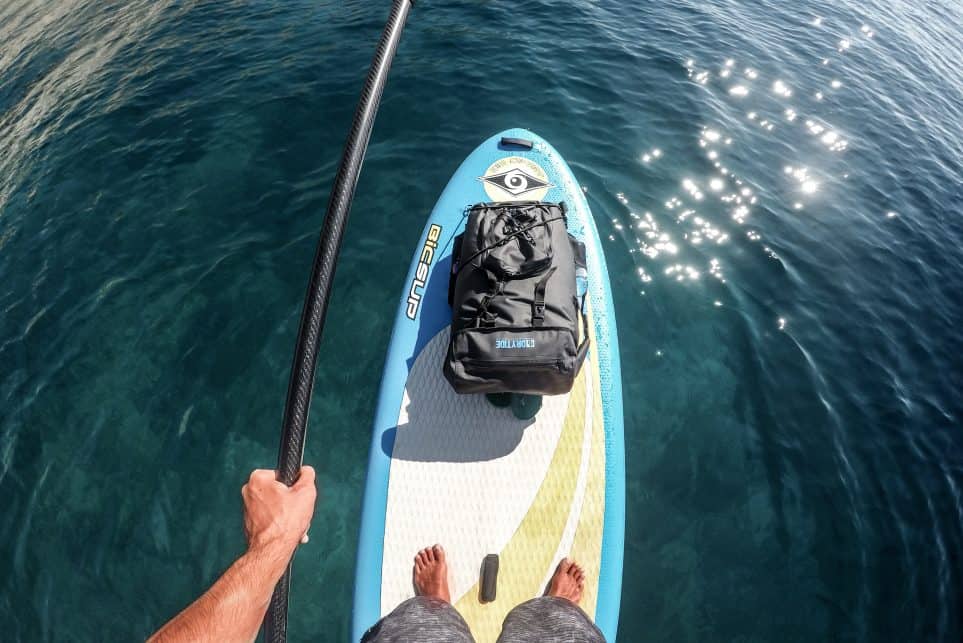
Personal Floatation Device
Personal floatation devices (PFDs) are commonly known as life jackets. They’re precautionary items worn by paddle boarders. Usually people don’t use them, but depending on the conditions, weather etc… they can become very useful and can even save your life. This is why it is advisable to at least have a PFD with you on your paddle board and then use it if necessary.
You could either have your PFD inflated before getting on the water or go on the water with a pump to get the PFD working only when you need it. For less skilled paddle boarders, it’s advisable to inflate their PFD before paddle boarding.
Fins
These are detachable add-ons or permanently fixed to paddle boards. These small attachments help to keep the paddle board in a straight line while paddling. They prevent the tail of the board from slipping sideways when you paddle. Of course if you only paddle on one side of the board the board will still start to turn, so you have to alternate sides every few strokes. But without fins paddle boarding would be virtually impossible.
Detachable fins make it easy to replace them or use different fins for different conditions (only for expert paddle boarders). Fixed board fins can cut through water a bit better, but if you break them you will need to bring your whole board to the shop to get them fixed.
Paddle Board Leash
Paddle board leashes are essential for the safety of the paddle board and the paddle boarder while on water. Loss of paddle boards is one of the major danger that you face when paddle boarding. Paddle board losses are either caused by the weather (strong wind that can quickly move a lost board over the surface so you can not reach it), by natural features (like reefs, rocks, and debris on the water, in this can you can usually retrieve the board quite easily) or by moving water (rivers, sea currents etc… that again prevent you from reaching your board afer falling off). With a leash attached to your leg, your board will always be within reach.
A leash attaches the paddle boarder’s leg to the paddle board, either at the ankle or the calf. Paddle board leashes are either straight or coiled. The length of a paddle board leash is usually a bit longer than the paddle board. If you will be paddling in very turbulent waters (like rivers etc…) the get a breakaway leash that can be quickly released if the board is pulling you into a dangerous situation.
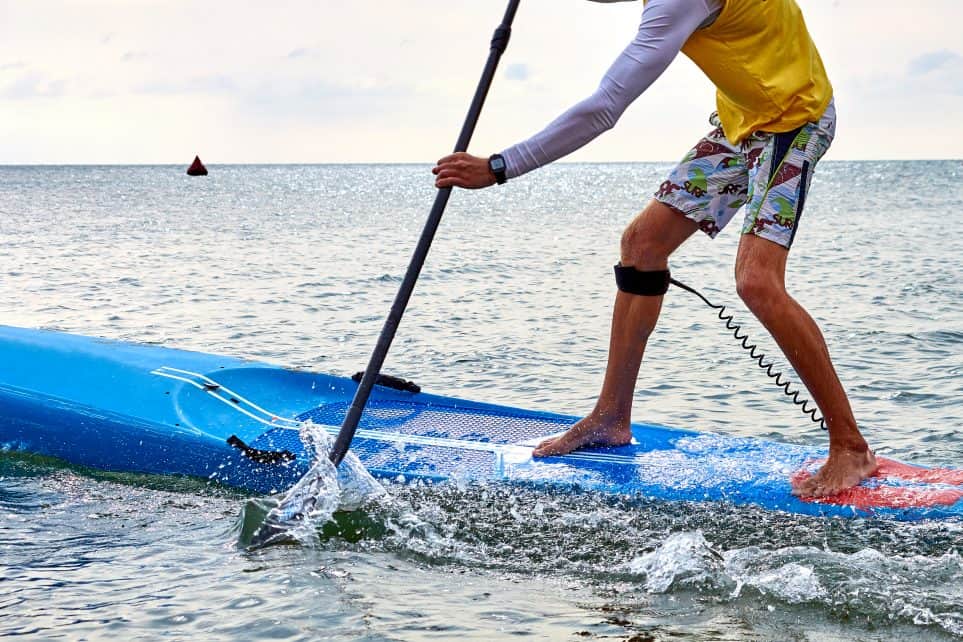
Rescue Whistle
When paddle boarding, there will be moments where you could get thrown off balance and fall of your board. If you are in moving turbulent water there is also a risk drowning. Apart from having a PFD and a breakaway leash, a rescue whistle can also be a lifesaver. Usually
The first cue for anyone thrown off balance while on the water is to shout. However, shouting inside water expedites the loss of oxygen. Rescue whistle helps you alert other people that you are in trouble without loosing much energy. Lots of life jackets already come with rescue whistles installed. Most rescue whistles can also be heard even underwater.
Light Source
We usually go paddle boarding during the day. However, especially on longer trips (check this multi day sup travel guide) there is a chance of getting caught in the dark while paddle boarding. In this case having a light source can be a great help. The main purpose of a light on a paddle board is to alert others of your location. So you don’t get run over by boats etc… If you are not really close to shore, no light is strong enough to illuminate a far away beach that you are looking for. You will have to rely on navigation, natural light (moon and starts) and artificial lights on the shore (lighthouse, towns…etc.). This is why paddle boarding at night takes some experience. If you are not prepared for it then it’s better to stick to day paddling.
There are different paddle boarding lights to use in paddle boarding. Some lights are used solely as position lights, other can also illuminate your way to some extent. Btw, make sure your lights have sufficient power to last your whole night paddle board expedition.
Rash Guard
Rash guards, sometimes referred to as rashies, rash vests or Lycras are usually long or short sleeve shirts that protect you from the sun and from the rashes caused by abrasion (like constant rubbing of your skin against neoprene, against your paddle board etc…). Rash guards are a great alternative to wet suits in warmer climates. Other pieces are also available (not just shirts).
Water Shoes
Water shoes are specific shoe that are suited for paddle boarding and other water sports. These shoes can be used in water and on dry land. They drain quickly, don’t move around when wet and they don’t get ruined by water. They usually have a mesh top, mostly made of cloth materials and a hard sole. The hard sole protects your feet when walking on rocks and entering and exiting water etc… While the mesh top, which is made of cloth, allows for breathability. Other types of water shoes include water sandals and water socks. A good place to get water shoes is SwimOutlet.
Swimsuit and Swim Trunks
Swimsuits or swim trunks are used interchangeably in water sports. Swimsuits are great for warm weather and tropical climates. When the weather gets colder some paddle boarders also use wetsuits. Wetsuits will keep your body warm while on the water and even when they get wet. So if there is a chance of getting wet during your paddle boarding trip use a wetsuit. If not, you can just wear regular warmer clothes.
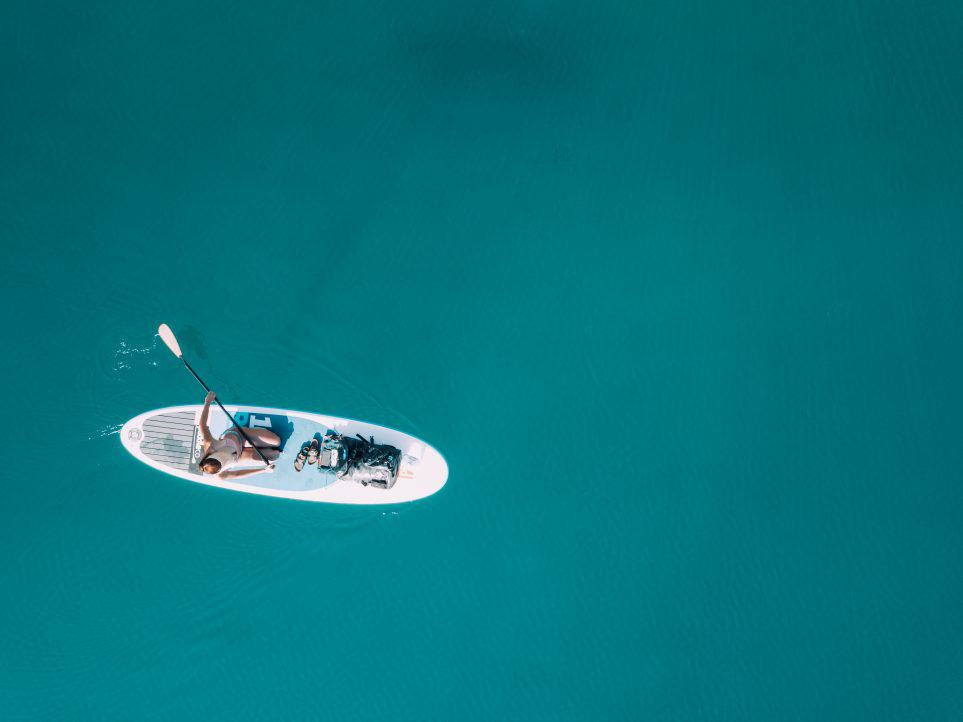
Sunscreen
Sunscreen is used for protection from harmful UV rays of the sun. UV rays and the sun’s intense heat result in burns, excessive skin damages and in some cases even skin cancer. For individuals who value their skin, which all paddle boarders should, especially if you spend a lot of time in the sun, sunscreen should be applied every time they’re out on the water.
Sunscreen protection level is marked with Sun Protection Factor (SPF). You choose the level of protection considering the season (hot summer sun vs. milmder winter sun), location (near equator or far north or south) and your skin type (how tanned you are). In any case, SPF shouldn’t be less than 15 or it won’t have much effect.
SPF Lip Balms
Lips are a very sensitive part of the body that we usually miss when applying sunscreen. Sunscreen also does not really work for the lips. You should get a special lip balm that contain SPF. Lots of lip balms (lip gloss and lipsticks) have no protection against the sun. So make sure you use one that comes with sun protection factor.
Sun-shielding Hats
Even with sunscreen and lip balm, a sun shielding hat is a must-have out on the sea. They’re great for eye and facial skin protection. With a hat on casting shadow over your eyes you can more easily look at the reflective water surface, especially if you don’t have sunglasses.Wide-brimmed hats, shade caps, or baseball caps with their visors should do the trick. Wide-brimmed hats and shape caps cast a bigger shadow that covers a wider range of your upper body. Baseball style caps focus on the head and face.
Water Bottle
Always bring something to drink when you go on paddle boarding trips. This way you will be able to stay hydrated during an intensive paddle boarding session. Being hydrated during paddle boarding doesn’t mean water is your only choice. You can bring juice, iced tea, soft drinks or special rehydration drinks.
Weather Jacket
If you are not paddle boarding in the middle of a hot summer, then a weather jacket offers great protection from wind and colder weather on the water. You can use either an “ordinary” rain jacket or a special “kayaking” style jacket, that is completely waterproof. Jackets also have pockets for your phone, snacks etc… Jacket will also protect you from the sun although in summer a jacket is an overkill that will result in lots of sweating:).
Paddle Gloves
There are two types of paddle gloves. There are paddle gloves that are meant to be used with paddles. These will help you keep your hands warm on water in cold weather and will protect your hands from abrasions, cuts and blisters while paddling. They also help paddle boarders keep a consistent grip on the paddle. You can get full-fingered and three-quartered fingered ones.
The other version of paddle gloves are gloves that are meant for paddle boards where you paddle with your hands. These are special webbed gloves that put extra fabric in between your finger so you can “grip” more water when you paddle and paddle faster.
Rucksacks and Backpacks
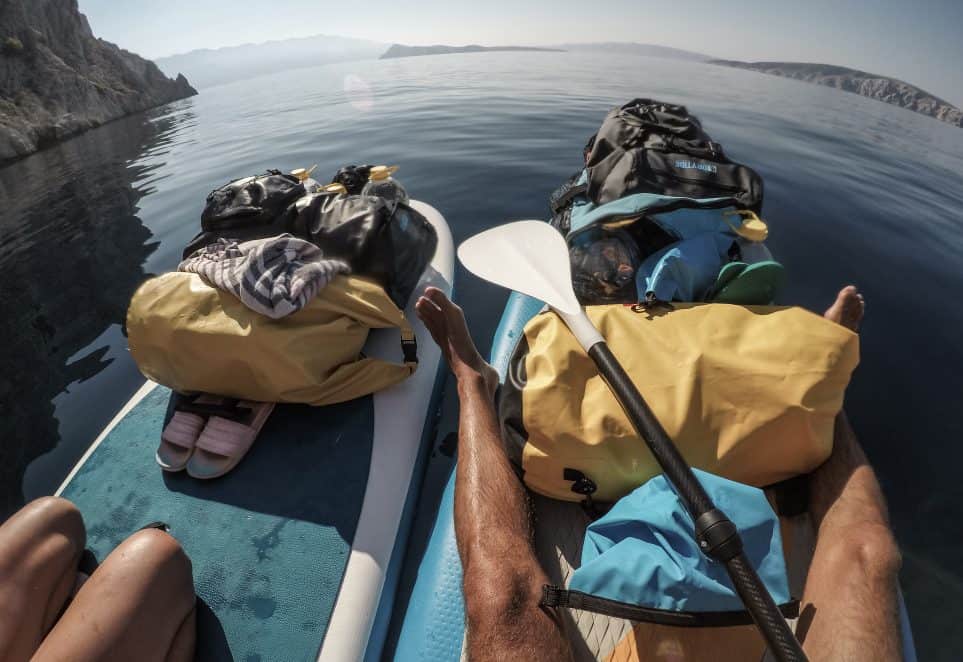
For all the above mentioned items you need something to store them in. If you are going on a bit longer trip you will probably also take things like food, towel, drinks, beach mat, book, bluetooth speakers, power bank, camera, extra swimsuits etc… All these items can quickly get wet if you put them directly on to your paddle board or even worse, in no time they will drop off the side of the board and into the sea. So paddle boarders use special bags called dry bags to store these items. Dry bags are bags that are constructed in such a way that they are 100% waterproof. That means that they can be dropped into the sea and the inside of the bag will stay dry.
Dry bags come in different sizes, depending on how much gear you are taking with you. It is also better to have more smaller bags than one really big one, this way finding things will be easier. An upgrade from these simple dry bags are dry backpacks. These are full blown backpacks made using the same technology as dry bags. They are also 100% waterproof.
Backpack are much easier to carry around and have more pockets and straps to organize your belongings. One of the best bags and backpacks are made by DryTide.
The above list of essential items for paddle boarding is sufficient for almost any paddle board trip. These items will protect your from the environment and equip you with everything you need for paddle boarding. Of course this list is by no means finished. Many paddle boarders use numerous other items when the go out. You will probably learn from experience and add a few more things to the list after a few trips.

